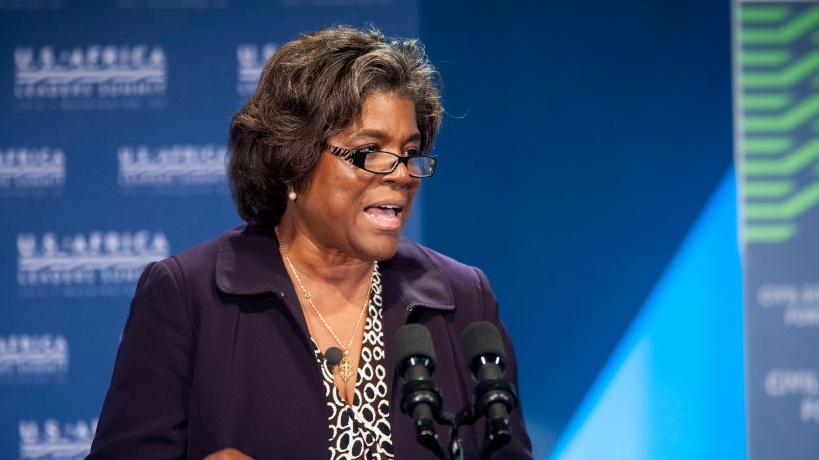President-elect Joe Biden announced several key choices for his foreign policy and national security team on Monday. While he has not yet nominated any of the individuals that Blavity previously identified as potential Black cabinet picks, one nominee who stands out is Linda Thomas-Greenfield. The career diplomat and Louisiana native is Biden’s pick for United States Ambassador to the United Nations, a cabinet-level position that serves as one of the most important foreign policy positions in the U.S. government. Although she is not a household name, Thomas-Greenfield has had an incredible career trajectory and history.
Here are five things to know about the Black woman who is likely to become America’s most prominent ambassador.
1. She endured going to college with David Duke, who'd go on to become a notorious KKK leader
Thomas-Greenfield grew up in Louisiana in what she describes as a "town in which the KKK regularly would come on weekends and burn a cross in somebody's yard."
After graduating in 1970 from a segregated high school, Thomas-Greenfield chose to attend Louisiana State University for college. Though integrated, LSU was not at the time a particularly welcoming atmosphere for Black students. This was especially true due to the presence of another undergraduate at the time – David Duke, the future Grand Wizard of the Ku Klux Klan. Duke first gained national attention during his LSU days, as he paraded around campus in Nazi-like gear, made daily racist and anti-Semitic speeches, and founded the White Youth Alliance, a campus branch of a larger neo-Nazi organization, the National Socialist White People's Party.
As Thomas-Greenfield later described Duke, “He was preaching the same hatred, anti-Semitism, white supremacy that he preached in Charlottesville, Va," she said in reference to the violent 2018 Unite the Right rally.
2. She survived the 1994 Rwanda genocide
After graduating from LSU and earning a master’s degree at the University of Wisconsin, where she also did doctoral work, and teaching at Bucknell University, Thomas-Greenfield entered into foreign affairs.
According to her State Department bio, she served in a number of countries including Pakistan, Kenya, The Republic of Gambia, Nigeria and Jamaica over a career spanning more than three decades.
Thomas-Greenfield narrowly escaped death in 1994 after arriving in Rwanda the day before the genocide began. Standing 6 feet tall with dark skin, she fit the stereotypical description of a woman from the Tutsi ethnic group, the main targets of the genocide killers, and was held at gunpoint by men threatening to execute her. She managed to convince her captors that she was American and was spared, an incident she described in a 2019 TED Talk.
3. She worked with Africa’s first elected female president
Thomas-Greenfield has visited or lived in Liberia at several points in her career.
She conducted graduate research in the country while a student at the University of Wisconsin. In 2005, she was part of a U.S. delegation that observed the 2005 Liberian presidential election. That election was won by economist Ellen Johnson Sirleaf, who became the first elected female head of state in Africa. Thomas-Greenfield was appointed United States Ambassador to Liberia in 2008, a post she held until 2012.
Serving as Ambassador to Liberia during Sirleaf’s administration, Thomas-Greenfield worked closely with the Liberian president and helped promote Sirleaf to western audiences. “We see her as one of us,” Thomas-Greenfield said of Sirleaf in 2010.
4. She served as U.S. Assistant Secretary of State for African Affairs Under President Obama
In 2013, Thomas-Greenfield was appointed by President Barack Obama to serve as Assistant Secretary of State for African Affairs, the top State Department official in charge of policy concerning Africa. She joined a distinguished list of diplomats to serve in this role, including Susan Rice and Jendayi Frazer. Thomas-Greenfield held the position during the world’s worst Ebola outbreak, which occurred in West Africa from 2014 to 2016, and she helped shape U.S. policy to help contain the deadly disease.
5. She hopes to fix the State Department and repair the U.S. relationship with the United Nations
The Trump administration forced out many career diplomats from the State Department and refused to refill many of the positions, leaving the agency understaffed and demoralized.
Like many State Department officials, especially women and people of color within the agency, Thomas-Greenfield was pressured to leave once the Trump administration took power. As Blavity previously reported, Thomas-Greenfield said after her 2017 retirement that she did not “feel targeted as an African American.” Rather, she said, “I feel targeted as a professional.”
Trump publicly berated the United Nations and even withdrew the United States from the UN Human Rights Council, creating a tense relationship between the United States and the international organization.
Earlier this year, Thomas-Greenfield co-authored an op-ed in Foreign Affairs magazine outlining a plan to revitalize the State Department. The piece argued, among other things, that the State Department should be repopulated, and that the principles of diversity, inclusion and equity should be among the driving factors for evaluating new hirers. The memo painted the lack of diversity in the agency as a “national security crisis” and argued that “study after study has shown that more diverse organizations are more effective and innovative organizations.” Now, having set an agenda for repairing the State Department that the Biden team seems poised to follow, Thomas-Greenfield will also have the opportunity to repair the relationship between the United States and the United Nations.
